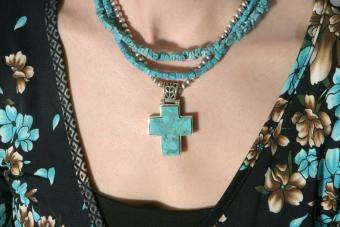
Although the natural form of the mineral was discovered at the end of the 19th century, cubic zirconia's history doesn't really begin until decades later, when a practical application for the mineral was found.
Natural Form of Zirconium Oxide
The natural form of cubic zirconia is zirconium oxide, which is yellow in appearance. It was first discovered in 1892, but the mineral wasn't considered to be of any value. Sometime in the early 1930s, interest in the mineral was revived as scientists conducted experiments that included melting the ore. It was discovered during this process that the mineral didn't lose its strength when subjected to extremely high heat, making it what is known as a "refractory material." This was an important discovery and allowed inventors to use zirconium oxide in various refractory applications, such as an abrasive material, for ceramics, and to create certain pigments.
Modern Cubic Zirconia History
In 1937, two German mineralogists made an important discovery in Cubic zirconia's history. The scientists found that melted zirconium oxide contained cube-shaped crystals. While this was a unique characteristic to any mineral, the men didn't understand it as being anything useful since the same properties also existed in the mineral's natural state. That redundancy seemed inconsequential to both men, and so they simply ignored their find. As with all scientific discoveries, the honor of naming the object or process is given to the one(s) making the discovery. In this case, neither man even considered naming their find, so cubic zirconia retained its scientific name. The world continued to overlook the mineral and its potential for several more decades.
Searching for Industrial Materials
In the 1960s, as scientists searched for a less expensive material to be used with lasers and other industrial applications, researchers began to pursue the creation of simulated diamonds. It was during this time that the single crystal cubic zirconia was rediscovered and quickly put to industrial use.
In France, scientists developed a technique dubbed, "cold crucible," in which they melted zirconia to force the crystals to grow within the solid zirconia shell. This process resulted in rather small crystals that weren't of much commercial value or application.
It wasn't until 1973, when Soviet scientists at Lebedev Physical Institute (FIAN, Russian acronym) in Moscow created a different technique known as "skull crucible," that the mineral finally became valuable. They named their crystal after the institute funding them, FIAN. With the production in full swing by 1976, the commercial demand for FIAN took off, and four years later, the international production of commercial FIAN was over 50 million carats per year.
Cubic Zirconia Takes Its Place in Jewelry History
In 1977, Russian scientists discovered how to actually grow these crystals using a synthetic process. They named their synthetic crystals Djevalite. It was under this name that they began to market them as simulated diamonds.
Djevalite never really impacted the jewelry marketplace. In fact, it was some time later in the 1980s when these substitutes for diamonds became fashionable. That was thanks to the world-renowned maker of fine lead crystals, Swarovski, jumping into the market with its own version of cubic zirconia. Swarovski coined the abbreviated term CZ for cubic zirconia. This was the jumpstart this crystal needed. It was nearly 90 years after it was first discovered that CZ became a popular and cheaper substitute for real diamond jewelry.
CZ Advances and Improvements
Manufacturers feel they have an ongoing mission to improve the appearance of CZ and enhance its resemblance to diamonds. One of the newer innovations is the application of a finishing coat with a compound known as DLC (diamond-like carbon). Another popular coating is amorphous diamond. Manufacturers claim that both of these coatings reinforce the hardness of the CZ and also enhance its luster.CZ has two things that prevent it from having an identical appearance to diamonds. It has more fire than a diamond and sparkles in rainbow colors. It also has a lower refractive index than a diamond. The two new coatings are said to contain properties that make CZ more diamond-like by dulling the fire and improving the refractive index, closing the gap between diamonds and CZs. It's important to note that the amorphous coating, when applied to CZ, will give a false positive diamond reading when placed under a Raman spectroscope that's used to authenticate diamonds. This property can sometime fool the less astute jeweler, who may judge the stone to be a diamond.
Some manufacturers are also using "vacuum sputtering," a process which involves applying a thin layer of gold over gemstones such CZ. This method of enhancement, unlike the other two coatings mentioned, eventually wears off.
Another advancement in CZ technology has been the introduction of color, which allows for CZ creations that resemble colored gemstones.
Does CZ Have a Future in Your Jewelry?
Cubic zirconia has a fascinating history, both in industrial use and in jewelry. Wondering if you're ready to make the switch from diamonds to this created stone? Keep the following facts in mind:
- The weight of a CZ crystal is about 75 percent more than that of a diamond. This means if you compare one-carat diamond to a similarly-sized CZ, the CZ comes in weighing around 1.75 carats.
- You might expect CZ to be as hard as a diamond. In reality, CZ is softer and more brittle than a diamond, so it can't be used to cut glass the same way a diamond can.
- Unlike diamonds that have inclusions or imperfections, CZ is flawless.
- CZ is fairly cheap to purchase and makes a great substitute for more expensive diamonds in some jewelry applications.
Whether or not you choose to buy jewelry featuring cubic zirconia, it's fun to know the history of this created gem.







